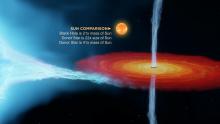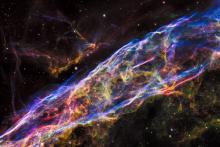Listen to today's episode of StarDate on the web the same day it airs in high-quality streaming audio without any extra ads or announcements. Choose a $8 one-month pass, or listen every day for a year for just $30.
You are here
Chi Cygni
When a star is in the prime of life, it can shine steadily for billions of years. As it begins to die, though, it can change in a hurry. A star near the neck of the swan, for example, pulses in and out like a beating heart. That causes its size and brightness to change dramatically.
Chi Cygni is about 600 light-years away, in Cygnus, the swan. The constellation stands high overhead at nightfall.
Chi Cygni is in the final stages of life. It’s burned through the hydrogen in its core to make helium. Now, it’s burning hydrogen and helium in shells around the core.
And that makes the star unstable. Its outer layers fall inward, which makes the surface hotter and brighter. It makes the layers around the core hotter, too. The hotter gas traps energy from the core, which then pushes outward, causing the star to get bigger. But as it does so, it gets cooler, so the star gets smaller. Each pulse takes about 13 and a half months.
At its biggest, the star is almost 350 million miles wider than at its smallest. And at visible wavelengths, it can get more than ten thousand times brighter.
Chi Cygni’s overall brightness doesn’t vary nearly as much, though. At its biggest, the star emits mostly infrared energy, which isn’t visible to the human eye. As it contracts and gets hotter, though, it produces mainly visible light. So at its peak, the star is just visible to the unaided eye. And in between, it’s in-visible — hiding along the neck of the swan.
Script by Damond Benningfield






